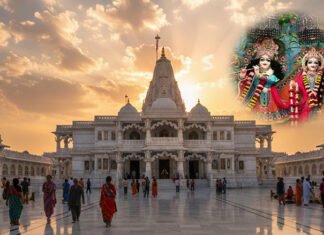Introduction:
Nestled in the quaint village of Vemulawada in the Rajanna Sircilla district of Telangana, the Sri Raja Rajeshwara Swamy Devasthanam stands as a beacon of spiritual heritage and architectural brilliance. This ancient temple is dedicated to Lord Eashwara and holds a significant place among the Shivate temples of India. The temple is categorized as a Regional Joint Commissioner Cadre Temple, highlighting the Sri Raja Rajeshwara Swamy Temple Vemulawada its importance and grandeur, the Vemulawada temple is renowned not only for its spiritual sanctity but also for its magnificent architecture.
The Deity and Divine Benevolence
The presiding deity of the temple, Lord Raja Rajeshwara, is worshipped in the form of “Neela Lohitha Siva Lingam. Devotees visit this sacred site to receive divine blessings from the Lord, who is renowned for fulfilling their wishes. This temple fondly referred to as ‘Dakshina Kasi’ or Southern Banaras, also boasts the title of “Harihara Kshetram” due to the presence of two significant Vaisnava temples within its complex: the Sri Anantha Padmanabha Swamy Temple and the Sri Seetharama Chandra Swamy Temple. Sri Anantha Padmanabha Swamy, the Guardian Deity. They are honored with grand celebrations of both Shivate and Vaisnavate festivals. First, there is Sreerama Navami, and then other significant events follow. Furthermore, these festivals are celebrated with equal fervor, and what’s more, the festivities continue throughout the year. Finally, each occasion adds to the vibrant tapestry of devotion at the site.
A Symbol of Religious Harmony
A unique feature of the Vemulawada temple complex is its inclusion of a Temple, symbolizing religious tolerance and harmony. This inclusion underscores the temple’s welcoming embrace of diverse faiths and its historical role as a confluence of spiritual paths.
Also read: Top 5 Powerful Temples and Religious Sites to Must Visit in Khammam
Sthalapuranam and Mythological Significance
According to the Bhavishyothara Purana, the Sun God, Surya Bhagavan, regained his health by praying at this sacred shrine, earning it the epithet “Bhaskara Kshethram.” Furthermore, it is said that Indra, the King of the Astadikpalakas, purified himself from the Brahmahatya Dosham by devoutly worshipping Lord Sri Raja Rajeshwara. Another fascinating legend speaks of Raja Narendra, the grandson of Parikshit, who was also the grandson of Arjuna. Moreover, this story unfolds further, revealing an intriguing connection to royal lineage. Furthermore, Raja Narendra’s tale adds another layer of historical significance. Finally, it enriches our understanding of the grand heritage and intricate relationships of ancient royalty. Who was cured of leprosy after bathing in the temple’s sacred Dharmagundam (Pushkarni)? He reportedly received a vision from Lord Sri Raja Rajeshwara and Goddess Sri Raja Rajeshwari Devi. Directing him to build a temple and install the Shiva Lingam from the Pushkarni.
Historical Significance
The temple’s historical roots trace back to the period between 750 and 973 AD when the region served as the capital of the Vemulawada Chalukyas. This dynasty was instrumental in the temple’s construction and the promotion of its cultural and spiritual significance. Rock-cut inscriptions discovered at the site refer to the village as Lemulavatika, highlighting its ancient heritage. The area is also linked to notable literary figures, with traditions associating the place with the famous Telugu poet Bheemakavi. More definitively, it is recognized as the residence of the celebrated Kannada poet Pampa, who served as the court poet of Arikesari II and dedicated his renowned work “Kannada Bharatha” to his royal patron.
Also read: Best Heritage Buildings in Warangal A Journey Through History
Temple Architecture and Rituals
The Vemulawada Raja Rajeshwara Temple is beautifully situated on the banks of the large Gudicheruvu Tank, adding to its picturesque setting. The temple complex, an architectural marvel, features various shrines like Sri Lakshmi Ganapathi, Goddess Raja Rajeshwari Devi, and Nandeeshwara. The sanctum sanctorum also encloses several other temples such as the Sri Anantha Padmanabha Swamy Temple, Sri Seetharama Chandra Swamy Temple, Sri Anjaneya Sahitha Kasi Visweswara Swamy Temple, Sri Dakshina Murthy Temple, Sreeevalli Devasena Sametha Subramanya Swamy Temple, Sri Bala Tripura Sundari Devi Temple, Sri Someshwaralayam, Sri Uma Maheshwaralayam, Sri Mahisasura Mardhani Temple, Kotilingalu, and Sri Kala Bhairava Swamy Temple.
Rituals in the main shrine are conducted following the Smartha Agama, while the Vaisnavate temples within the complex observe the Pancharathra Agama. Lord Raja Rajeshwara’s icon is venerated daily through Prathakala, Madhyahnika, Pradosakala, and Nishikala Pujas, known as Chatukala Pujas. The goddess Sri Raja Rajeshwari Devi and Sri Lakshmi Ganapathi in the Maha Mandapam undergo similar rituals, highlighting the temple’s spiritual depth.
Also read: An Exclusive History of Sri Meenakshi Agasteswara Swamy Temple
Sri Raja Rajeshwara Swamy Temple Vemulawada timings:
- Everyday 4:00 AM to 10:00 PM
- “For updated information on timings and pooja schedules, check here.“
Conclusion:
The Sri Raja Rajeshwara Swamy Devasthanam at Vemulawada is more than a temple; it embodies India’s rich spiritual heritage, history, and culture. It’s a blend of architectural splendor. Historical significance and religious harmony make it a must-visit destination for devotees and tourists. Offering a glimpse into the divine and the ancient traditions that have shaped this sacred site.
“We’d love to hear from you! Whether you have a question, feedback, or a travel story to share, feel free to get in touch with us. Here’s how you can contact us:”
Frequently Asked Questions(FAQs)
Answer: The temple is open daily from 4:00 AM to 10:00 PM.
Answer: The temple is renowned for its spiritual sanctity, historical significance, and unique architectural features.
Answer: Major festivals include Sreerama Navami, celebrated with both Shivate and Vaisnavate rituals.
Answer: The main deity is Lord Raja Rajeshwara, with other deities including Sri Anantha Padmanabha Swamy and Goddess Sri Raja Rajeshwari Devi.
Answer: For the latest updates on timings and pooja schedules, check the official temple website or visitor information centers.











